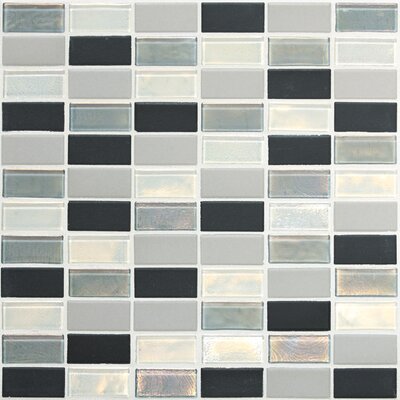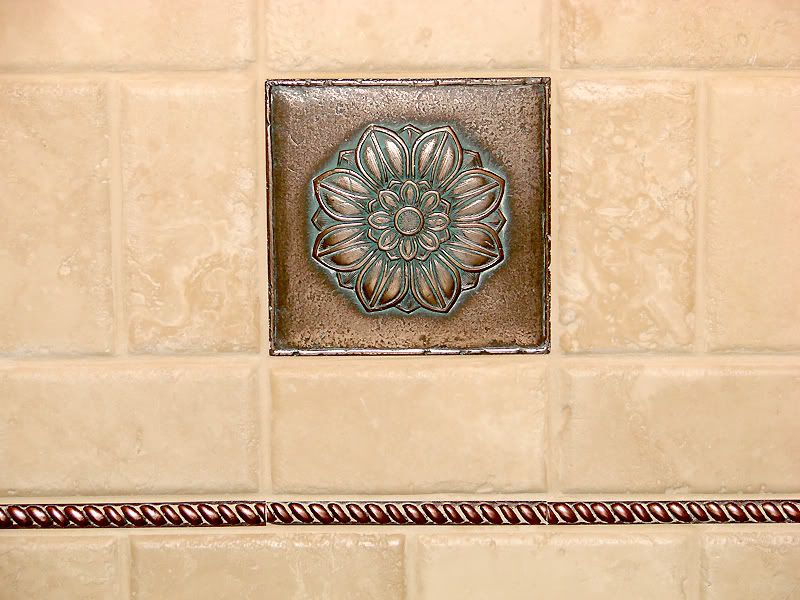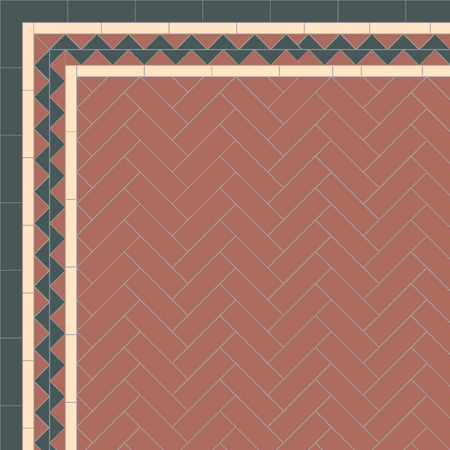Photos at https://www.pinterest.com/realtyproadvisr/tile/
Hooray! You just listed a luxury home for sale. But it includes 5 different types of tile on the floors, counters, shower wall, backsplash, and fireplace. How do you determine each style so you can showcase your new listing?
Later, you’re out viewing homes with buyers and they notice cracked tile and decaying grout. How do you recognize and identify construction issues so you can explain them to your buyers?
Today’s topic is a primer on tile types, materials, and patterns. We’ll also give a brief tour of tile installation, because poor installation is the basis for tile problems that you may encounter while selling homes.
What is Tile?
Look for vibrant colors, interesting styles, and unique tile around the house. Thin glass tile in a green and gold design is perfectly eye-catching for a bathroom and bronze or copper tiles make an astonishing kitchen backsplash.
Popular in Mediterranean architecture, tile floors look classic in Spanish-style homes. Fireplaces tiled with stone are elegant and timeless; marble flooring is an indication of luxurious indulgence. Tile can date a house when they reflect specific eras. For example: kitchen counters tiled with pink squares were popular in the 1950’s, and the small hexagon black and white tile on the bathroom floor is a classic 1930’s look.
Tiles are similar-sized pieces of flat, hardened clay that are permanently installed onto a floor or other surface. They are manufactured in thin squares (or other geometric shapes) and installed in a pattern with grout in between the tiles. Besides clay, other tile materials include quarried stone, manufactured metal, cement fiberboard, and formed or recycled glass.
Just to clear the confusion, “tiling” and “to tile” are verbs that refer to the processing of installing tile onto a surface. “Tiled” is an adjective that refers to a surface onto which tile was installed. The term “tile” may also refer to a building material applied in squares, such as carpet tiles which are squares of carpet installed individually. Rubber tiles can be effective garage flooring.
Advantages
Besides aesthetic beauty of the materials, colors, and patterns, tile is preferred for its clean-up ease. It is strong and durable in heavy-traffic areas. One huge advantage is that broken tiles can be removed and replaced, which cannot be done with vinyl. And in a warm climate, tile floors keep a house cooler.
Drawbacks
As a hard surface, tile is difficult to stand on continuously. Installation is permanent which means that removal is difficult. Tile can be mis-installed which causes problems for homeowners; and grout risks decay from mildew due to water intrusion. Porous tile, such as marble and stone, needs to be polished and sealed periodically.
Surface Durability Ratings
When buyers select a home, they should ensure that the surface durability of tile matches the intended usage. Can the entry way endure wear and tear from guests, children, and pets? Is the kitchen tile floor tough enough to withstand heavy traffic?
The PEI (Porcelain Enamel Institute) rates the surface durability of tile with the following 5 categories that apply to residential usage, classified as follows:
- Wall installation only, not suitable for floors
- Floors with light traffic
- Floors with moderate traffic, but no heavy objects (such as a car in a garage)
- Floors with heavy traffic
- Floors with very heavy traffic
Other measurements of quality besides the PEI ratings include: moisture absorption, tile density, and Mohs scale (mineral hardness and scratch resistance). Tile with a texture or a raised pattern has a higher COF (Coefficient of Friction), which means it is less slippery in wet areas. Consult your tile store vendor for more information.
Tile Types & Styles
The splendor of tile is that it can be installed in a plethora of patterns using basic materials in surprisingly simple shapes. A wide assortment of tile colors and textures lend to the artistic beauty of tile floors, walls, and counters.
Materials
Tile materials include:
|
Clay Great for outdoors: walkway, front entry, and patio
|
|
|
Ceramic Used indoors and often have a slick, shiny (glazed) surface. Popular for kitchen counters & backsplashes because they can withstand heat.
|
|
|
Porcelain Made from 50% clay and 50% white “feldspar” sand. More expensive but more durable than ceramic. |
|
|
Natural Stone Quarried from mines and cut from slabs. Porous, but can be polished and sealed. Every tile is unique due to the patterns of nature. Textured tiles are ideal for wet floors such as bathrooms.
|
|
|
Glass Can be made from recycled materials. Mostly decorative, such as a backsplash or accent wall. Can be mixed with stone or ceramic tiles. |
|
|
Metal Copper, bronze, pewter, or other metals can be manufactured into thin tiles. Ideal for backsplashes or small accent walls. |
|
Sizes & Shapes
Some basic sizes and shapes of tile include:
- Squares (8”, 12”, and 16” are common)
- Rectangles (oblong) (4” x 6” and 12” x 18” are typical)
- Long / thin rectangles (4” x 8” and 2” x 10” are typical)
- Ovals (very small; used for accents)
- Hexagons (6 sides) (1” is common)
- Octagons (8 sides) (1” is common)
Often, 2 or more sizes and shapes are combined into a layout pattern, as shown below.
Patterns of Layout
Refer to our illustrations to get a bird’s-eye view of the following popular patterns.
|
Straight Box Grid (AKA “Straight Lay” or “Simple Grid”) Squares are lined up at the seams, installed in rows parallel to the walls, resulting in a plain box pattern. |
|
|
Straight Rectangle Grid Same as the straight box grid, but with rectangles. |
|
|
Checkerboard Alternating 2 different colors on every other square, with no same colors adjoining. Think: the classic old-fashioned 50’s style black-and-white soda fountain store. |
|
|
Waffle A checkerboard pattern, with one of the two colored tiles consisting of several textured tiles as one. |
|
|
Diagonal (AKA “Diamond”) Same as the straight lay, except that tiles are tilted at a 45° degree angle in a diagonal pattern. The look is a bit classier than the straight box grid. |
|
|
Diamond Diagonal pattern with diamond-shaped tiles. |
|
|
Dotted Diagonal same as the diagonal pattern, except that tiny accent tiles are inserted at every other corner. It really elevates the design of the diagonal style. |
|
|
Alternating Square tiles alternated with rectangle tiles half the size of the squares. “Alternating Centered” pattern is a variation. |
|
|
Running Bond Every other row is alternated by placing the tile seam halfway in between the adjacent rows of tiles. |
|
|
Brickwork (AKA “Subway” style) Same as “Running Bond”, except it applies to longer, rectangular sized tiles. “Staggered Brickwork” is a variation with only partial overlap. |
|
|
Lacework Same as “Brickwork”, except that the brick-shaped tiles are alternated with square tiles half the size. |
|
|
Pinwheel (AKA “Hopscotch”) One small square tile has 4 larger square tiles running around it. |
|
|
Windmill 1 square tile is surrounded by 4 rectangle tiles, each of which are twice the size of the square tile, to create the effect of boxes with “overlapping” sides. |
|
|
Soldiered Similar to a windmill pattern, except that each rectangle tile is complemented by a small square tile to make the pattern complete. |
|
|
Circular Rectangular Bricks-sized tiles arranged lengthwise around a circle shape. |
|
|
Herringbone (AKA “Chevron”) Long narrow tiles are placed in a “V” shape, alternating up and down. |
|
|
Basketweave Creates the illusion of a woven basket by alternating square tiles textured vertically and rectangular tiles textured horizontally. |
|
|
Brickweave Hybrid between the “Brickwork” and “Basketweave” patterns. Uses brick-shaped tiles in a Basketweave pattern. |
|
|
Hexagon 6-sided tiles are laid out with each edge touching the next. Colored tile may be used to create various patterns. |
|
|
Corridor A row of squares, alternated by a row of rectangle tiles that are half the size of the squares. |
|
|
Cobblestone Each “square” is composed of many rectangular and square tiles. |
|
|
Interlocked A mixture of various sized tiles arranged in a random-looking pattern. |
|
|
Mosaic (AKA “Kaleidoscope”) Decorative tiles of various shapes inserted to create an intricately detailed pattern. |
|
|
Pentagon Diamonds Straight grid pattern with a small square inserted in the center of the seams, and set at a diagonal angle. |
|
|
Versailles 4 various sizes of tiles form a sophisticated asymmetrical pattern. |
|
|
Stepping Stone Small square tiles in a neutral color with periodic rows and columns of a bright, contrasting tile create the illusion of large, separate squares. |
|
|
Border Patterns Long tiles on the top and bottom of a running pattern, with an intricate pattern running inside the length. |
|
|
Accent Any small pattern used as an accent to a larger pattern. |
|
|
Insert A small pattern inserted inside of a larger pattern. For example, a grid pattern floor with a diagonal pattern inserted in the center area. |
|
|
Liner Border Long, thin tiles laid end-to-end to create a running edge, often separating two tile patterns (for example, to set off the “insert” pattern; refer to above). |
|
|
Zig-Zag Border Right triangles alternated around the edge of another pattern to create a border. “Diamond Border” is another variation. |
|
Installation
Proper installation of tile is the key to durability and assurance that it will last for many years. Enthusiastic DIY’ers may not be aware of professional installation techniques and can make rookie mistakes. These errors may not always be visible, but as the tile is used, the robustness will be tested and lack of resiliency becomes apparent. Listed below are some of the tile problems that buyers encounter.
Uneven tiles probably mean that the installer did not use the same size spacers consistently between the seams. Tiles that wiggle might mean they were not adhered using thinset mortar. Wobbly tiles could mean that the grout was not cured by waiting at least a day before using it.
Gaps between the tile floor and the wall show that the installer did not measure properly or use trimwork. An uneven drop-off between flooring types may indicate missing transition strips.
Jagged corners, too-short tile, and big gaps are indications that the tile installers did not use the proper tools. Tiles must be cut with a diamond-blade tile saw table, keeping it wet while cutting. Nippers are tools used to snip the corners, and a file is used to smooth the edges.
Cracked tiles may indicate (1) lack of proper underlayment, (2) too thin of a tile for heavy usage; or (3) a shifting slab foundation (common in California houses). As a Realtor® it’s critical to spot potential problems for your buyers, and advise them of the importance of a professional home inspection.
Underlayment
Buckling, cracked, or missing tile may indicate that the tile was not installed on top of substantial underlayment, a signal of poor quality construction. Buyers should ask their home inspector to pay special attention to tile floors in this condition.
Tiles can be installed over any hard, level surface, including old vinyl or linoleum flooring, hardwood, or even the concrete foundation. However, the durability of the tile depends largely on surface prepping and underlayment.
The purpose of underlayment is to protect the floor against moisture damage, to create a smooth surface that levels out the foundation, and to absorb weight from heavy traffic. Popular underlayment includes:
- “Rubber” tile membrane (with a “waffle” grid) for floors & counters
- Kraft paper (grade “B”) laminated with asphalt and aqua bar
Backerboard (cementitious type) along with a felt moisture barrier (for shower stalls) - Greenboard sheetrock (for walls, counters, & floors, but not water proof for shower/tub enclosures)
- Natural cork (floors) – with a waterproof membrane
- Vinyl sheet (floors)
- Plywood, chip board, or particle board – but may not be suitable for floors
Quality prep materials prevent the tile from contracting and expanding, reduce noise by absorbing sound, and eliminate mold and mildew. Look for underlayment created from natural or recycled materials.
Grout
Grout is the gritty filler mixture applied between tile seams. It dries to a hard surface (similar to concrete or stucco) and keeps the tiles in place. Grout can be either unsanded or sanded (to prevent cracking in wide seams). Silicone caulking may also be used as a grout in bathrooms near the edge of the tile.
Grout is porous (absorbs water) so it must be sealed to repel water. Sealer should be re‑applied periodically to prevent mildew and erosion. Unsealed grout causes many problems in the home, such as mold in humid areas (bathroom shower walls), stains in areas with spills (kitchen counters), and deterioration in heavy-use areas (flooring).
Grout is available in a wide variety of colors, such as dark colors (to hide dirt) or colors that contrast to the tiles and creates an eye-catching pattern. Grout may also be painted with a special grout paint, so watch out for grout that looks new and clean, but it is actually old, dirty, or moldy grout that was painted.
Alternately, tiles may be butted up next to each other without grout. This style is primarily for decorative applications, such as fireplace surrounds. Also, metal rods may be installed in the seams, rather than grout. You may see metal seams in heavy-duty commercial applications, such as airports.
Radiant Heat
Warm tiles under morning toes is a bathroom trend growing in popularity. Tile is cold and therefore not seen often in chilly climates. However, with radiant tubes installed underneath the tile to heat it, tile is gaining acceptance in the Mid-West and other cold winter climates. An under-tile heat mat is another way to install heated tiles, and should be used in conjunction with a heat-resistant underlayment.
Conclusion
With your new-found knowledge about tile, you can feel confident advertising your new luxury listing featuring a marble entryway, a travertine tile fireplace, subway tile in the shower, and recycled glass backsplash in the kitchen. And you can spot tile patterns such as pinwheel, windmill, and basketweave.
Now that you understand tile installation, you can explain to your buyers that the cracked tile could be due to incorrect installation, and may not necessarily indicate a cracked foundation. Also you can alert them to have the sparkling, glistening “white” grout in the bathroom inspected for mildew, as it appears to have been painted recently. Of course any potential issues would be verified by a home inspector, but they are relying on your experience and knowledge to point out “red flags” before purchase.
And that’s why YOU are the best Realtor® in the neighborhood!
Article as published in The San Diego Realtor® magazine, pages 20-23.
Read more in our "Learn the Lingo" series:
1) Backyard & Outdoor Structures: Learn the Lingo
2) View From the Windows: Learn the Lingo
3) Architectural Styles: Learn the Lingo - Part 1
4) Architectural Styles: Learn the Lingo - Part 2
5) Learn the Lingo: Luxury Bathrooms
6) Learn the Lingo: Fences & Gates
7) Learn the Lingo: Vintage Features of Historic Homes
8) The Kitchen: The Heart of the Home Can Be Gourmet
9) The Gourmet Kitchen: Everything and the Kitchen Sink
10) Open the Door of Possibilities (Exterior Doors)
11) The Difference a Good Door Makes (Interior Doors)
12) Tiles
13) Sustainable and Eco-Conscious Home Features (Part 1)
14) Sustainable and Eco-Conscious Home Features (Part 2)
15) Sustainable and Eco-Conscious Home Features (Part 3)
16) Roof Architecture – Don’t Let it Go ‘Over Your Head’
17) Let There Be Light Fixtures ... And There Are Many!
18) A Discussion of Ceilings Will Have You Looking Up
19) Fireplaces: Literally the Hearth of the Home
20) Learn the Lingo of Walls
21) Apply Your Knowledge to Major Appliances
22) Don't Be Floored By this Topic: It's Right Under Your Feet
23) HVAC / Mechanical Lingo
24) Rural Properties - A Sustainable Life "Off the Grid"
25) Land Usage, and Showing & Selling Rural Properties
26) The Dramatic Effect of Stairs and Staircases - A Flight of Fancy?
27) Electrical Components - Get Wired for Understanding
28) Learn the Lingo: Plumbing Fixtures (Part 1 of 2)
29) Learn the Lingo: Plumbing Fixtures (Part 2 of 2)
30) Swimming Pool and Spa Lingo






































Comments(8)